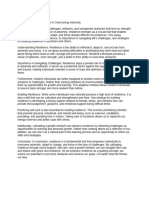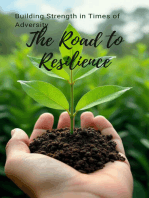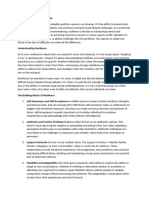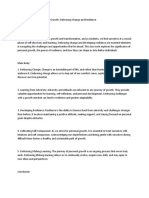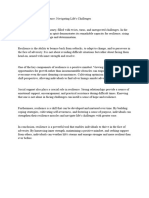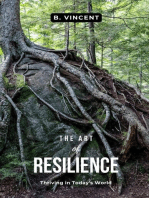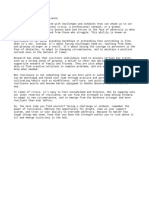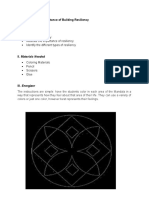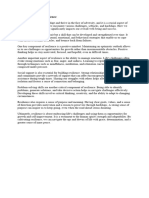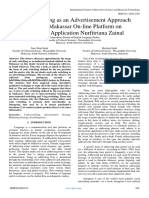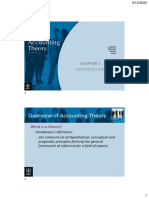The Art of Learning Resilience (English Version)
The Art of Learning Resilience (English Version)
Uploaded by
zaogamerCopyright:
Available Formats
The Art of Learning Resilience (English Version)
The Art of Learning Resilience (English Version)
Uploaded by
zaogamerCopyright
Available Formats
Share this document
Did you find this document useful?
Is this content inappropriate?
Copyright:
Available Formats
The Art of Learning Resilience (English Version)
The Art of Learning Resilience (English Version)
Uploaded by
zaogamerCopyright:
Available Formats
THE ART OF LEARNING RESILIENCE (ENGLISH)
Embarking on the transformative journey of learning resilience is an exploration into
the art of navigating life's challenges with grace and fortitude. Beyond the trials and
tribulations, resilience is a dynamic skill set that empowers individuals to adapt,
persist, and grow in the face of adversity. This journey involves cultivating a mindset
of adaptability, fostering emotional strength, and developing positive coping
mechanisms. Learning resilience is not just about bouncing back; it's a profound
exploration of bouncing forward, using setbacks as stepping stones to personal and
professional growth.
1. Adaptability in the Face of Challenges:
Idea: Learning resilience is akin to mastering the art of adaptability. It
involves developing the capacity to navigate unexpected challenges,
setbacks, and changes with composure and resourcefulness.
Thought: Resilience is not just about bouncing back; it's about
bouncing forward, using adversity as a catalyst for personal and
professional growth.
2. Embracing a Growth Mindset:
Idea: At the core of resilience lies a growth mindset—a belief in one's
ability to learn and adapt. Embracing challenges as opportunities for
learning and improvement is fundamental to cultivating resilience.
Thought: Learning resilience involves shifting perspectives, viewing
obstacles as stepping stones to success rather than insurmountable
barriers.
3. Building Emotional Strength:
Idea: Resilience is intertwined with emotional strength. It involves
developing the ability to manage and channel emotions effectively,
fostering a sense of inner strength during challenging times.
Thought: Learning resilience equips individuals with emotional
intelligence, enabling them to navigate stress, uncertainty, and setbacks
with grace.
4. Fostering Perseverance and Tenacity:
Idea: Resilience is synonymous with perseverance and tenacity. It
involves cultivating the determination to persist in the face of
difficulties, staying committed to long-term goals despite obstacles.
Thought: Learning resilience means understanding that setbacks are
temporary, and success often requires sustained effort and a refusal to
succumb to discouragement.
5. Cultivating a Supportive Network:
Idea: Resilience is not a solo endeavor; it thrives in a supportive
environment. Learning resilience involves cultivating meaningful
relationships and seeking support when needed.
Thought: Building a network of encouragement and guidance
enhances one's ability to weather storms and emerge stronger on the
other side.
6. Adopting Positive Coping Mechanisms:
Idea: Resilience is bolstered by adopting positive coping mechanisms.
It involves developing healthy strategies for managing stress, adversity,
and pressure.
Thought: Learning resilience is about consciously choosing responses
that promote well-being and foster a sense of control in challenging
situations.
7. Learning from Setbacks:
Idea: Resilience involves extracting lessons from setbacks. It requires
the ability to reflect on experiences, understand what went wrong, and
use that knowledge to inform future actions.
Thought: Every setback becomes a stepping stone to resilience,
offering valuable insights that contribute to personal and professional
development.
8. Cultivating Self-Compassion:
Idea: Resilience is intertwined with self-compassion. Learning resilience
involves treating oneself with kindness and understanding during
challenging times, fostering a sense of inner strength and self-belief.
Thought: Acknowledging one's own worth and treating oneself with
empathy enhances the capacity to navigate difficulties with resilience.
9. Applying Resilience in Various Life Domains:
Idea: Resilience is a versatile skill applicable in various life domains—
personal, professional, and academic. Learning resilience involves
recognizing its universal value and applying it across different aspects
of life.
Thought: Resilience is a skill set that transcends specific challenges,
contributing to a well-rounded and adaptable approach to life's
complexities.
10. Fostering a Culture of Resilience:
Idea: Learning resilience extends beyond individual development; it
involves fostering a culture of resilience within communities and
organizations. It requires creating environments that support and
encourage resilience in collective endeavors.
Thought: Building resilient communities and workplaces enhances the
collective ability to face challenges and thrive in the midst of
uncertainty.
n concluding this expedition into the art of learning resilience, we recognize that it is
more than a skill; it's a proactive approach to life's uncertainties. By embracing a
growth mindset, fostering emotional strength, and adopting positive coping
mechanisms, individuals can not only weather storms but emerge stronger on the
other side. Resilience is a versatile skill applicable across diverse life domains, and as
we cultivate this ability, we contribute not only to our personal well-being but also to
the creation of resilient communities and workplaces. In the art of learning resilience,
challenges become opportunities, setbacks become stepping stones, and each
experience becomes a chapter in a journey of continuous growth and adaptation.
You might also like
- Lulu One Deception To Rule Them All PDFDocument452 pagesLulu One Deception To Rule Them All PDFDave Burgzorg100% (6)
- Time RealityDocument9 pagesTime RealityShuvam Sarkar RoyNo ratings yet
- The Power of ResilienceDocument1 pageThe Power of ResilienceJunnel Eswar Dutta AP21110011448No ratings yet
- The Resilient You: Building Strength in the Face of ChallengesFrom EverandThe Resilient You: Building Strength in the Face of ChallengesNo ratings yet
- English Holiday HomeworkDocument5 pagesEnglish Holiday HomeworkRudraa SinghNo ratings yet
- The Art of ResilienceDocument1 pageThe Art of Resiliencelamphanhello2005No ratings yet
- Adversity IntelligenceDocument12 pagesAdversity Intelligenceaadnane.aboutalebNo ratings yet
- Module 7Document7 pagesModule 7Hassan AskariNo ratings yet
- The Power of Growth MindsetDocument1 pageThe Power of Growth Mindsetmbielesza3No ratings yet
- Ai Generated ESSAY 7Document2 pagesAi Generated ESSAY 7cacaomilatoNo ratings yet
- Building Resilience Strategies For Overcoming Adversity and Thriving in Challenging TimesDocument1 pageBuilding Resilience Strategies For Overcoming Adversity and Thriving in Challenging Timesmipeper994No ratings yet
- Building Resilience Strategies For Overcoming Adversity and Bouncing Back StrongerDocument2 pagesBuilding Resilience Strategies For Overcoming Adversity and Bouncing Back Strongermipeper994No ratings yet
- The Role of Resilience in Overcoming AdversityDocument1 pageThe Role of Resilience in Overcoming AdversitydsltopgNo ratings yet
- The Road to Resilience: Building Strength in Times of AdversityFrom EverandThe Road to Resilience: Building Strength in Times of AdversityNo ratings yet
- Building Resilience: Strategies to Overcome Challenges and Develop a Growth MindsetFrom EverandBuilding Resilience: Strategies to Overcome Challenges and Develop a Growth MindsetNo ratings yet
- ResilienceDocument3 pagesResiliencearidj gaderNo ratings yet
- The Adversity Quotient - Navigating Challenges With Resilience and DeterminationDocument4 pagesThe Adversity Quotient - Navigating Challenges With Resilience and Determinationjoshua barcomaNo ratings yet
- Bouncing Back Stronger: Mastering The Art Of Resilience In The Face Of AdversityFrom EverandBouncing Back Stronger: Mastering The Art Of Resilience In The Face Of AdversityNo ratings yet
- From Mindfulness to Mindset: Cultivating Resilience in a Chaotic WorldFrom EverandFrom Mindfulness to Mindset: Cultivating Resilience in a Chaotic WorldNo ratings yet
- Resilience and Overcoming Adversity: Thriving in the Face of ChallengesFrom EverandResilience and Overcoming Adversity: Thriving in the Face of ChallengesNo ratings yet
- STATEMENT OF PURPOSEDocument10 pagesSTATEMENT OF PURPOSEgunjankingrani0410No ratings yet
- The Power of ResilienceDocument1 pageThe Power of ResilienceranjeewaNo ratings yet
- Resilience Is T-WPSDocument4 pagesResilience Is T-WPSRajinderKumarNo ratings yet
- Title - The Jour-WPS OfficeDocument2 pagesTitle - The Jour-WPS OfficesafwanNo ratings yet
- Navigating Life's ChallengesDocument1 pageNavigating Life's ChallengesanggalionixNo ratings yet
- Gen Ed 9 Fixed and Growth Mindset Leory Ozias AbranillaDocument11 pagesGen Ed 9 Fixed and Growth Mindset Leory Ozias Abranillabsj25s6554No ratings yet
- My Life Mantra Forget Mistakes Remember The LessonsDocument8 pagesMy Life Mantra Forget Mistakes Remember The Lessonssanchik546No ratings yet
- Patience RewardDocument14 pagesPatience RewardHamiz MuzaffarNo ratings yet
- 1518003732ContentNote_ResilienceCopingDocument8 pages1518003732ContentNote_ResilienceCopingAnkush LaybarNo ratings yet
- Resilience in AdversityDocument3 pagesResilience in Adversitysecret3191No ratings yet
- stu1Document2 pagesstu1Areeha ZahidNo ratings yet
- CourageDocument2 pagesCourageDarlene ReyesNo ratings yet
- From Setbacks to Success: The Secrets of Resilient People and How to Apply Them to Your LifeFrom EverandFrom Setbacks to Success: The Secrets of Resilient People and How to Apply Them to Your LifeNo ratings yet
- Elivation MindsetDocument1 pageElivation Mindsetitsjayantkumar77No ratings yet
- Mental Toughness Mastery : Archive your Ambitions Through Self-ControlFrom EverandMental Toughness Mastery : Archive your Ambitions Through Self-ControlNo ratings yet
- School Presentation.pptx_20241123_080328_0000Document9 pagesSchool Presentation.pptx_20241123_080328_0000anya.forger.sugarNo ratings yet
- Resilient AttitudeDocument3 pagesResilient AttitudeSakthiiNo ratings yet
- The Power of Resilience_ Overcoming Adversity (Essay)Document1 pageThe Power of Resilience_ Overcoming Adversity (Essay)malcom.buckshawNo ratings yet
- Essay About ResilienceDocument2 pagesEssay About ResiliencensyamarthiNo ratings yet
- English ASL Project (Final)Document40 pagesEnglish ASL Project (Final)cehsp11759No ratings yet
- The Art of Resilience - Overcoming Life's ChallengesDocument1 pageThe Art of Resilience - Overcoming Life's Challengeshogobay680No ratings yet
- The Power of ResilienceDocument1 pageThe Power of ResilienceBeniNo ratings yet
- Vinushree 12B English IPDocument22 pagesVinushree 12B English IPVinushree SanthoshkumarNo ratings yet
- Navigating Change - Strategies For Embracing Transformation and Thriving Amidst UncertaintyDocument3 pagesNavigating Change - Strategies For Embracing Transformation and Thriving Amidst UncertaintyKay KayNo ratings yet
- Unbreakable: Building Resilience for Life’s Toughest MomentsFrom EverandUnbreakable: Building Resilience for Life’s Toughest MomentsNo ratings yet
- Life SkillsDocument17 pagesLife SkillsAliaNo ratings yet
- Welcoming ChallengesDocument10 pagesWelcoming Challengesmanavnagar710No ratings yet
- To Define Resiliency Illustrate The Importance of Resiliency Identify The Different Types of ResiliencyDocument17 pagesTo Define Resiliency Illustrate The Importance of Resiliency Identify The Different Types of Resiliencybilly bongNo ratings yet
- The Road To Self-ImprovementDocument5 pagesThe Road To Self-ImprovementJHANRICK BINUNGCALNo ratings yet
- Welcoming ChallengesDocument10 pagesWelcoming Challengesmanavnagar710No ratings yet
- MODULE ResiliencyDocument16 pagesMODULE Resiliencybilly bongNo ratings yet
- Essay 3Document1 pageEssay 3gracelovesgodlovesme0722No ratings yet
- Alere SD Bioline HIV 1/2 BrochureDocument2 pagesAlere SD Bioline HIV 1/2 Brochurekevin shahNo ratings yet
- Visbreaking ModelDocument13 pagesVisbreaking ModelMaileen Julissa Hoyos CastellanosNo ratings yet
- CBCA en Adultos - Amado, Arce, Fariña y VilariñoDocument10 pagesCBCA en Adultos - Amado, Arce, Fariña y VilariñoCesar AcarapiNo ratings yet
- Polynomials Synopsis: + BX + C Where A, B, C Are Real + BX + CX + D, Where A, B, C Are RealDocument9 pagesPolynomials Synopsis: + BX + C Where A, B, C Are Real + BX + CX + D, Where A, B, C Are RealThanveer AhmadNo ratings yet
- Math 1100Document3 pagesMath 1100nasherlydiazNo ratings yet
- The Identification and Attribution of Christaan Huygen's First Pendulum ClockDocument9 pagesThe Identification and Attribution of Christaan Huygen's First Pendulum ClockWolfram BodenmuellerNo ratings yet
- Visual Programming NotesDocument16 pagesVisual Programming NotesAdilyt yttNo ratings yet
- Janapriya Multiple Campus: BMTM / First Semester / ENG 111: English-IDocument3 pagesJanapriya Multiple Campus: BMTM / First Semester / ENG 111: English-ISophiya PrabinNo ratings yet
- Chlorine in New and Used Petroleum Products (High Pressure Decomposition Device MethodDocument5 pagesChlorine in New and Used Petroleum Products (High Pressure Decomposition Device MethodLisNo ratings yet
- How To Build An Effective Sales Territory PlanDocument4 pagesHow To Build An Effective Sales Territory PlanPuneet MishraNo ratings yet
- Sop On Sop Procedure - 1Document2 pagesSop On Sop Procedure - 1Prince MoniNo ratings yet
- OEC - Medicine 1 SBDocument146 pagesOEC - Medicine 1 SBელენე ბუჩუკურიNo ratings yet
- Y8 Revision Booklet-1Document24 pagesY8 Revision Booklet-1Farida Ghaly50% (2)
- Lecture 6 Part OneDocument11 pagesLecture 6 Part OneJaykeNo ratings yet
- INTP - Annual Report - 2018 - Lamp PDFDocument122 pagesINTP - Annual Report - 2018 - Lamp PDFFox IncNo ratings yet
- The Impact of Parenting Style On Social Adjustment of Adolescents: A Cross-Cultural PerspectiveDocument6 pagesThe Impact of Parenting Style On Social Adjustment of Adolescents: A Cross-Cultural PerspectiveKaryn Alyssa S. SalesNo ratings yet
- Math10 Q4 M8Document15 pagesMath10 Q4 M8ivymarish.bucoNo ratings yet
- Anima BookletDocument30 pagesAnima Bookletapi-652402360No ratings yet
- Code Switching As An Advertisement Approach Used by Makassar On-Line Platform On Instagram Application Nurfitriana ZainalDocument6 pagesCode Switching As An Advertisement Approach Used by Makassar On-Line Platform On Instagram Application Nurfitriana ZainalInternational Journal of Innovative Science and Research TechnologyNo ratings yet
- SEMI Detiled LP in Math 5Document6 pagesSEMI Detiled LP in Math 5MonicaDelaCruzMagistradoNo ratings yet
- Chapter 1 - IntroductionDocument13 pagesChapter 1 - IntroductionIvonne WijayaNo ratings yet
- Ch1. Understanding SociologyDocument27 pagesCh1. Understanding SociologynirobNo ratings yet
- Transient Analysis MaterialsDocument17 pagesTransient Analysis MaterialsWitchayut SudthanyaratNo ratings yet
- BEBEIU18187 - LeThiThuyHang - AE2 Writing Midterm - Test Paper & Answer Sheet (Online) 11.2021 - Ks Test 1Document5 pagesBEBEIU18187 - LeThiThuyHang - AE2 Writing Midterm - Test Paper & Answer Sheet (Online) 11.2021 - Ks Test 1Lê Thúy HằngNo ratings yet
- Rishu - Book Chapters-Springer ComplexityDocument13 pagesRishu - Book Chapters-Springer ComplexityBhupendra Kumar SharmaNo ratings yet
- Engineering Geology: Matthew D. Clark, Jennifer J. DayDocument21 pagesEngineering Geology: Matthew D. Clark, Jennifer J. DayDaniel Mauricio Rojas CaroNo ratings yet
- Machine Learning and Big Data Analytics in Power Distribution SystemsDocument54 pagesMachine Learning and Big Data Analytics in Power Distribution SystemsKailash KumarNo ratings yet
- What Is A Dictionary - Custom Translator - Azure Cognitive Services - Microsoft DocsDocument2 pagesWhat Is A Dictionary - Custom Translator - Azure Cognitive Services - Microsoft DocsgranainaNo ratings yet















